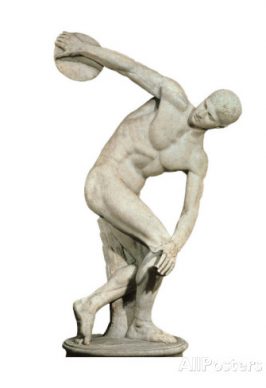Before students start to read the sermon, tell them to look for the primal human fears that Edwards used to motivate his congregation. As an alternative, teachers can provide information on primal fears, specifically the fear of falling. See information in the Helpful Background Section, above.
Another alternative, is to ask students to make a list of their primal fears. In all of these alternatives the primal fear of falling should be stressed. Teachers may want to also discuss with students “hypnic jerks” which 70% of people have when falling asleep.
If the sermon is being read in class, the film clip — first, sound only, and later, showing the dance,— can be used as relief from the tedium involved in reading the text. Alternatively, if the text is being read outside of class, the clip can be played before or after the sermon has been read.
In either case, the clip should be played for the class at least twice; the first time with just sound only.
The Song
To help students concentrate on the aural experience of listening to the song, consider telling them to shut their eyes while they listen.
After the class listens to the song, discuss how the imagery of the lyrics, the rhythm, the melody, and the intonation of the singer’s voice describe some of the concepts of the sermon. To complete this discussion it might be appropriate for teachers to play just the clip again (or even several times) with only the sound so that students have a chance to thoroughly analyze all aspects of the song. Consider asking to students to focus on one or two aspects of the song each time the clip is played.
Below are excerpts from the Sermon that can be compared with the lyrics and music of the song.
All wicked Men’s Pains and Contrivance they use to escape Hell, while they continue to reject Christ, and so remain wicked Men, don’t secure ’em from Hell one Moment.
If you cry to God to pity you, he will be so far from pitying you in your doleful Case, or shewing you the least Regard or Favour,
God hath had it on his Heart to shew to Angels and Men, both how excellent his Love is, and also how terrible his Wrath is.
These concepts are put to music in the clip. Click here for the lyrics to the song as sung by Billy Porter.
Only then should teachers show the dance.
At an appropriate point in the lesson, teachers can discuss with students the meaning of metaphor in its broader sense. See, for example, the information contained in The Metaphorical Basis of Artistic Expression, above. One or all of the questions set out below might be helpful in this discussion.
1. How does the image of the melting rock [the boiling sea] contained in the song expand the images of Mr. Edwards’ Sermon?
Suggested Response:
Strong responses will refer to the fact that only extraordinary heat will melt rocks [cause the sea to boil]; only God or natural forces in his control and not under the control of mankind could make the rock melt [the sea to boil]; melting rock [boiling sea] are hostile to life and will kill the sinner.
2. How did the experience of listening to the music of the song enhance your understanding of [appreciation for] Mr. Edwards’ Sermon?
Suggested Response:
Strong responses will refer to melody, rhythm, pacing, or inflection.
3. Listen to the song again. How does rhythm, melody, and the inflection of the singer’s voice, things that are dissimilar to the concepts expressed in the sermon, add meaning to the concepts of the sermon?
Suggested Response:
There is no one correct response. Here is one example relating to rhythm: The rhythm builds tension, it is relentless like the coming of Judgment Day and at the same time alarming; it is like running as the sinner runs to and for trying unsuccessfully to hide from God’s wrath.
The Dance
If the sermon is being read in class, resume reading for a while and then play the clip again, this time showing the dance. If students are reading the sermon outside of class, show students the dance after the discussion of the song as metaphor. Follow the first showing of the dance with a discussion about how the movement of the dancer’s bodies enhances the concepts from the Sermon and the song. Again, it might be appropriate to play the clip a third or fourth time to allow students to fully analyze the metaphors in the dance.
Finish this part of the lesson with a discussion of the metaphorical nature of the dance performance. One or both of the questions set out below might be helpful in this discussion.
4. How did the movement of the dancers’ bodies, things that are dissimilar to the concepts expressed in the sermon, enhance your understanding of [appreciation for] Mr. Edwards’ Sermon?
Suggested Response:
Strong responses will refer to the relationship of the movement of the dancers to specific concepts of the sermon.
5. Watch the dance again and analyze the movement of the dancers. How does the movement of the dancers show the flight, fear, pleading, despair, and final fall of sinners?
Suggested Response:
Here are some examples. Students will undoubtedly think of others: running to the edge of the dance area is the effort to hide and to run; arms outstretched shows pleading; spinning with hands in front of face shows useless searching for a place to hide; falling to the floor in almost a cartwheel with arms outstretched is the descent to Hell; repetition of movements echoes the repetition of concepts in the sermon.
Additional Discussion Questions:
6. Compare what happens when you dance at a party to the artistic dance shown in the film clip. How would you describe those differences?
Suggested Response:
A good discussion will include the following: (1) the dances have different purposes: social dancing is primarily for enjoyment and the dance shown in the clip is primarily for artistic expression and communication; (2) however, it is also a valid observation to say that they are both forms of expression and communication because social dancing can also express emotions such as joy or sexual attraction, and social dancing can also interpret the music; although usually dance as an art form has a broader range of expression; and (3) there are obvious differences in the level of technique.
7. How is a painting of a landscape or a portrait a metaphor? [This can be repeated for any work of art, a song, a sculpture, or a dance],
Suggested Response:
It describes something using dissimilar terms; e.g. color, line, and shape is used in a painting to describe physical objects and persons.
Assignments
1. Demonstrate, with or without music, the movements in the dance that show falling, pleading, fleeing, fear, and despair, or other concepts from the sermon.
2. In whatever artistic medium you choose, create a metaphorical expression for one or more concepts of the sermon.
3. Write a 1,500 word modern-day sermon making some of the core points from Edwards’ sermon using images tailored to modern culture.







